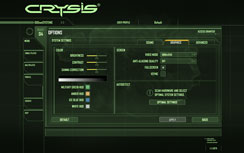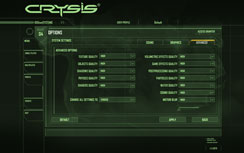Winter 2008 Graphics Performance Update
Written by Tim Smalley
November 10, 2008 | 11:21
Tags: #4870 #4870-x2 #9800-gtx #benchmark #benchmarks #crysis #fallout-3 #far-cry-2 #frame-rate #frame-rates #graphics-card #gtx-260 #gtx-280 #performance #radeon #testing #winter

Crysis
Publisher: Electronic ArtsCrysis is seen by many as the poster boy for DirectX 10 and it will make your system cry, quite literally – it’s a monster! It doesn’t come as much of a surprise then, that the graphics are something special – they’re above and beyond anything we’ve ever seen in a PC game.
We tested the game using the 64-bit executable under both DirectX 9.0 and DirectX 10 with the 1.21 patch applied. We used a custom timedemo recorded from the Laws of Nature level which is more representative of gameplay than the built-in benchmark that renders things much faster than you're going to experience in game. We found that around 27-33 fps in our custom timedemo was sufficient enough to obtain a playable frame rate through the game. It's a little different to other games in that the low frame rates still appear to be quite smooth.
In addition to testing under both DirectX 9.0 and DirectX 10 with all quality details set to High, we feel it's about time hardware should be able to handle the game with the in-game settings tuned to Very High. The game has been out for at least a year now, so it's time for hardware manufacturers to catch up with the software.
We forced 8x anisotropic filtering in the driver menu as there is currently no support for it in game and tested at 1,280 x 1,024, using 0x, 2x and 4x anti-aliasing, 1,680 x 1,050 using 0x and 4x anti-aliasing, 1,920 x 1,200 using 0x and 2xAA and 2,560 x 1,600 with 0xAA. By extensively testing using anti-aliasing in very high resolutions in conjunction with Very High quality in-game settings, we'll be pushing even the bleeding edge hardware on test to the limit.
Crysis
1,280 x 1,024 0xAA 8xAF, DirectX 10, Very High Quality
- ATI Radeon HD 4870 X2 2GB
- Nvidia GeForce GTX 280 1GB
- Sapphire ATI Radeon HD 4850 X2 2GB
- Nvidia GeForce GTX 260+ 896MB
- ATI Radeon HD 4870 1GB
- ATI Radeon HD 4870 512MB
- Nvidia GeForce 9800 GTX+ 512MB
- ATI Radeon HD 4850 512MB
-
-
48.4
-
29.0
-
-
-
40.7
-
23.0
-
-
-
40.5
-
24.0
-
-
-
35.6
-
20.0
-
-
-
30.1
-
17.0
-
-
-
30.0
-
16.0
-
-
-
29.7
-
17.0
-
-
-
23.6
-
12.0
-
0
10
20
30
40
50
Frames Per Second
-
Average
-
Minimum
Crysis
1,280 x 1,024 2xAA 8xAF, DirectX 10, Very High Quality
- ATI Radeon HD 4870 X2 2GB
- Sapphire ATI Radeon HD 4850 X2 2GB
- Nvidia GeForce GTX 280 1GB
- Nvidia GeForce GTX 260+ 896MB
- ATI Radeon HD 4870 1GB
- ATI Radeon HD 4870 512MB
- Nvidia GeForce 9800 GTX+ 512MB
- ATI Radeon HD 4850 512MB
-
-
46.1
-
28.0
-
-
-
37.4
-
22.0
-
-
-
36.5
-
21.0
-
-
-
31.6
-
18.0
-
-
-
28.0
-
15.0
-
-
-
27.4
-
15.0
-
-
-
24.5
-
14.0
-
-
-
21.5
-
10.0
-
0
10
20
30
40
50
Frames Per Second
-
Average
-
Minimum
Crysis
1,280 x 1,024 4xAA 8xAF, DirectX 10, Very High Quality
- ATI Radeon HD 4870 X2 2GB
- Nvidia GeForce GTX 280 1GB
- Sapphire ATI Radeon HD 4850 X2 2GB
- Nvidia GeForce GTX 260+ 896MB
- ATI Radeon HD 4870 1GB
- ATI Radeon HD 4870 512MB
- Nvidia GeForce 9800 GTX+ 512MB
- ATI Radeon HD 4850 512MB
-
-
43.9
-
26.0
-
-
-
35.3
-
20.0
-
-
-
34.7
-
19.0
-
-
-
30.5
-
18.0
-
-
-
24.6
-
14.0
-
-
-
23.7
-
14.0
-
-
-
23.1
-
12.0
-
-
-
19.3
-
9.0
-
0
10
20
30
40
Frames Per Second
-
Average
-
Minimum
Crysis
1,680 x 1,050 0xAA 8xAF, DirectX 10, Very High Quality
- ATI Radeon HD 4870 X2 2GB
- Sapphire ATI Radeon HD 4850 X2 2GB
- Nvidia GeForce GTX 280 1GB
- Nvidia GeForce GTX 260+ 896MB
- ATI Radeon HD 4870 1GB
- ATI Radeon HD 4870 512MB
- Nvidia GeForce 9800 GTX+ 512MB
- ATI Radeon HD 4850 512MB
-
-
40.9
-
25.0
-
-
-
33.3
-
20.0
-
-
-
31.9
-
18.0
-
-
-
27.9
-
17.0
-
-
-
24.0
-
14.0
-
-
-
23.7
-
13.0
-
-
-
22.8
-
14.0
-
-
-
18.6
-
10.0
-
0
10
20
30
40
Frames Per Second
-
Average
-
Minimum
Crysis
1,680 x 1,050 4xAA 8xAF, DirectX 10, Very High Quality
- ATI Radeon HD 4870 X2 2GB
- Sapphire ATI Radeon HD 4850 X2 2GB
- Nvidia GeForce GTX 280 1GB
- Nvidia GeForce GTX 260+ 896MB
- ATI Radeon HD 4870 512MB
- ATI Radeon HD 4870 1GB
- Nvidia GeForce 9800 GTX+ 512MB
- ATI Radeon HD 4850 512MB
-
-
34.9
-
22.0
-
-
-
28.2
-
15.0
-
-
-
27.4
-
17.0
-
-
-
23.6
-
14.0
-
-
-
20.1
-
11.0
-
-
-
19.9
-
10.0
-
-
-
17.1
-
10.0
-
-
-
15.2
-
7.0
-
0
5
10
15
20
25
30
35
Frames Per Second
-
Average
-
Minimum
Crysis
1,920 x 1,200 0xAA 8xAF, DirectX 10, Very High Quality
- ATI Radeon HD 4870 X2 2GB
- Sapphire ATI Radeon HD 4850 X2 2GB
- Nvidia GeForce GTX 280 1GB
- Nvidia GeForce GTX 260+ 896MB
- ATI Radeon HD 4870 1GB
- ATI Radeon HD 4870 512MB
- Nvidia GeForce 9800 GTX+ 512MB
- ATI Radeon HD 4850 512MB
-
-
36.2
-
22.0
-
-
-
28.9
-
16.0
-
-
-
25.7
-
15.0
-
-
-
22.3
-
13.0
-
-
-
21.1
-
11.0
-
-
-
20.7
-
11.0
-
-
-
17.7
-
11.0
-
-
-
16.0
-
8.0
-
0
10
20
30
40
Frames Per Second
-
Average
-
Minimum
Crysis
1,920 x 1,200 2xAA 8xAF, DirectX 10, Very High Quality
- ATI Radeon HD 4870 X2 2GB
- Sapphire ATI Radeon HD 4850 X2 2GB
- Nvidia GeForce GTX 280 1GB
- Nvidia GeForce GTX 260+ 896MB
- ATI Radeon HD 4870 1GB
- ATI Radeon HD 4870 512MB
- Nvidia GeForce 9800 GTX+ 512MB
- ATI Radeon HD 4850 512MB
-
-
33.1
-
19.0
-
-
-
26.0
-
15.0
-
-
-
22.7
-
14.0
-
-
-
19.6
-
11.0
-
-
-
19.2
-
10.0
-
-
-
18.7
-
10.0
-
-
-
14.4
-
8.0
-
-
-
14.3
-
7.0
-
0
5
10
15
20
25
30
35
Frames Per Second
-
Average
-
Minimum
Crysis
2,560 x 1,600 0xAA 8xAF, DirectX 10, Very High Quality
- ATI Radeon HD 4870 X2 2GB
- Sapphire ATI Radeon HD 4850 X2 2GB
- Nvidia GeForce GTX 280 1GB
- Nvidia GeForce GTX 260+ 896MB
- ATI Radeon HD 4870 1GB
- ATI Radeon HD 4870 512MB
- Nvidia GeForce 9800 GTX+ 512MB
- ATI Radeon HD 4850 512MB
-
-
21.9
-
11.0
-
-
-
17.4
-
9.0
-
-
-
15.2
-
7.0
-
-
-
13.2
-
6.0
-
-
-
12.4
-
6.0
-
-
-
12.0
-
5.0
-
-
-
9.8
-
4.0
-
-
-
9.4
-
4.0
-
0
5
10
15
20
25
Frames Per Second
-
Average
-
Minimum
It doesn’t take long for most of the cards we’ve tested here to start hitting unplayable frame rates – the Radeon HD 4850, for example, can’t even deliver 30fps at 1,280 x 1,024 with 0xAA, while both the GeForce 9800 GTX+ and Radeon HD 4870 only just manage to scrape by.
There’s little to no benefit to having more video memory in Crysis, even at very high quality settings, which means the 4870 1GB is only marginally faster than its 512MB sibling. Both the GeForce GTX 280 and Radeon HD 4850 X2 are pretty evenly matched until 1,920 x 1,200, where the 4850 X2 delivers a frame rate that’s close to playable while the GTX 280 doesn’t come close to delivering playable frame rates at this resolution. Both are ideally suited to playing Crysis with AA enabled at 1,680 x 1,050, though.
The one card that really stands out is the Radeon HD 4870 X2, which manages to deliver decent enough frame rates right the way up to 1,920 x 1,200 2xAA before performance takes a deep dive to the bottom of the ocean at 2,560 x 1,600 with AA disabled. No other card comes close to AMD’s current flagship product.











Want to comment? Please log in.